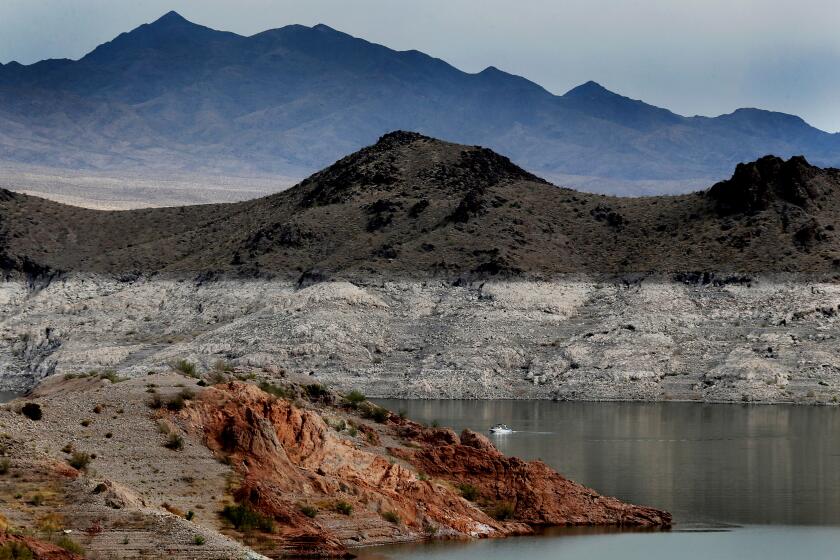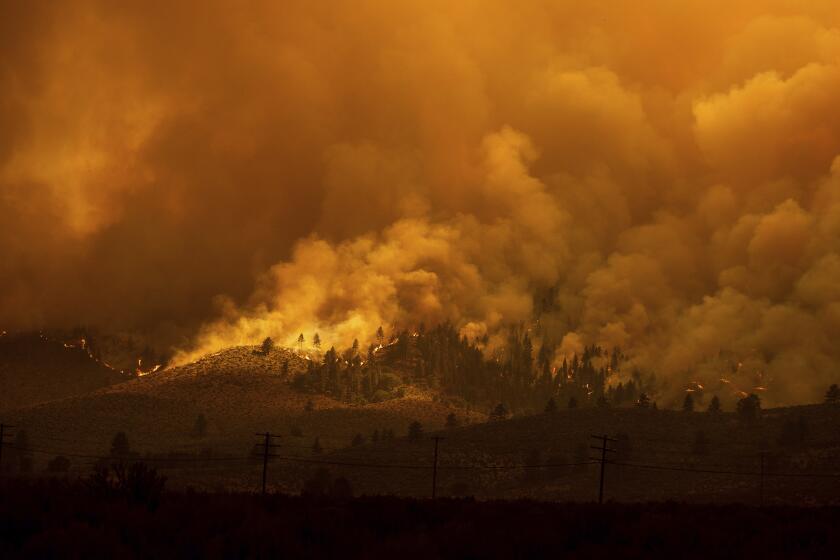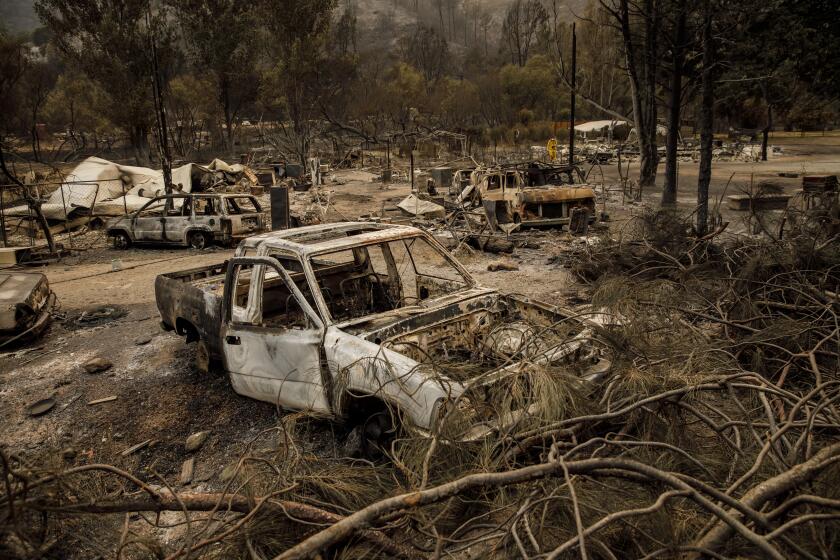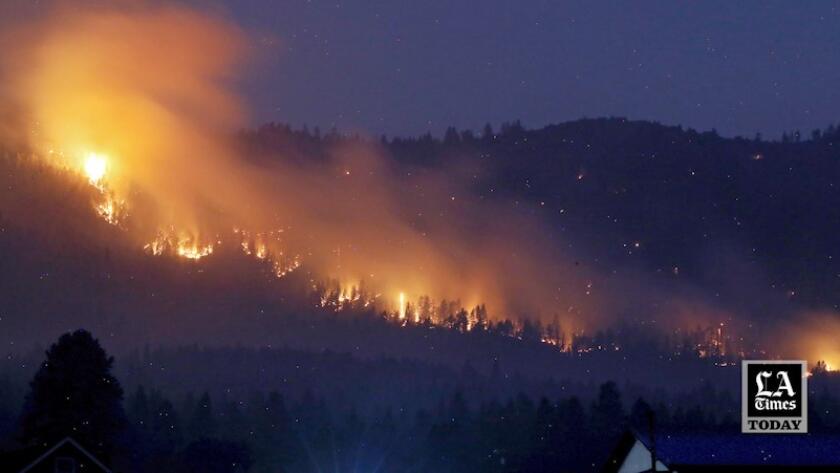Rampant wildfires once led to global mass extinction, scientists say. Can it happen again?
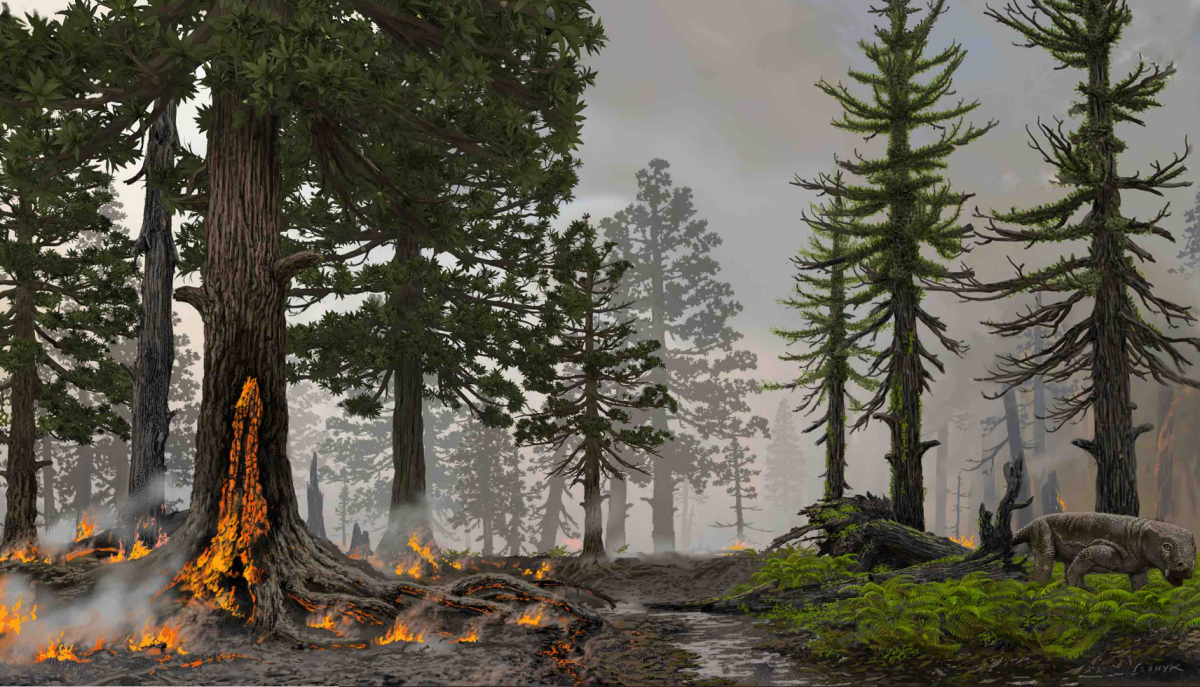
- Share via
A long time ago the carbon was rock, buried in the earth as securely as a secret. Then an environmental catastrophe of unprecedented scale began. The rocks burned, and the atoms inside them disassembled into carbon dioxide and other greenhouse gases.
Temperatures rose and wildfire — always a natural part of the ecosystem — became more frequent and more powerful. Forests disappeared into the flames. Carbon once stored inside countless leaves belched back into the atmosphere, which became hotter and drier, and the fires sparked even faster.
Without trees to hold them back, nutrients leached from denuded soil into lakes and streams. Those nutrients fed algae that bloomed in toxic quantities, while other species starved.
By the time it was over, most living things on Earth — up to 95% of ocean species, and more than 70% of those on land — were dead.
Record heat. Raging fires. What are the solutions?
Get Boiling Point, our newsletter about climate change, the environment and building a more sustainable California.
You may occasionally receive promotional content from the Los Angeles Times.
New research suggests the accelerating fires of this apocalyptic period 252 million years ago were not just a symptom of a warming planet, but a driver of extinction in their own right. Increasingly frequent fires overwhelmed plants’ ability to adapt and set off chains of events that threatened life in habitats untouched by flames themselves — just as scientists fear they are doing today.
These events took place in an event known as the End-Permian Extinction, or the Great Dying. Over tens of thousands of years, between the birth of the supercontinent Pangea in the Permian period and the emergence of the first dinosaurs in the Triassic, a series of interlocking climatic calamities extinguished most life on the planet.
Recurring drought and rising temperatures have already begun to alter the landscape of California and the American Southwest, researchers warn.
Though millions of years separate the events of the Great Dying from the wildfires threatening the modern world’s forests, the new study highlights eerie parallels between that ancient period of global warming and our own.
“There’s a sort of interplay between the present and the past,” said Chris Mays, a paleontologist at University College Cork in Ireland and lead author the study published last week in the journal PALAOIS.
Today’s vicious cycle of higher temperatures, less rainfall and more fires echoes the sequence of climate shifts that wiped out life late in the Permian, Mays said.
Though those long-ago disasters probably took place over thousands of years, the stark end result offers a sobering warning of what unchecked warming looks like.
“We’re warming up the world on the scale of hundreds of years, and there’s a good chance that when you increase temperatures and change the environment at such a rapid pace, that’s when ecosystems break down,” Mays said. “The pace of change is actually really important. And that’s where we actually see quite a concerning pattern today.”
The dryness of the vegetation, primed by both long-term drought and shorter-term heat waves, is making it easy for fires to ignite and even easier for them to spread.
Frequent wildfires caused by lightning and other natural events were a normal part of life in the Permian era, long before species began dying en masse. During their research in eastern Australia and Antarctica, Mays and his co-authors from the Swedish Museum of Natural History found shiny black shards of fossilized charcoal embedded amid fossilized plant life from the era, a signature of prehistoric wildfire. The fossil record showed that, much as they do today, plants in areas prone to fire had evolved adaptations to protect themselves from flames and regenerate faster after occasional burning.
Things changed after the start of a massive volcanic eruption in what is now the Siberia region of Russia. Lava and greenhouses gases spewed from the volcano for an estimated 2 million years, in a display less like Vesuvius and more like Hawaii Volcanoes National Park.
The enormous volumes of greenhouse gases emitted in this time warmed Earth cataclysmically. Average global temperatures likely rose 6 to 12 degrees Celsius (about 11 to 22 degrees Fahrenheit) near Earth’s equator, and 10 to 14 degrees Celsius (18 to 25 degrees F) near the poles. (For reference, climate scientists have cautioned that a 2-degree Celsius rise in average global temperatures today could kill 99% of the planet’s coral reefs and risk the collapse of the polar ice sheets.)
In this hotter, drier climate, fire frequency increased faster than plants could adapt. They were no longer able to ensure the forests’ sustainability, and a crucial source of carbon storage disappeared.
“The severe climate change and peak in fire activity during the extinction event seems to have pushed even these fire-adapted plants over a tipping point, from which the entire ecosystem could not recover for millions of years,” Mays and co-author Stephen McLoughlin wrote.
Understanding the largest extinction to take place on this planet offers valuable insights to later environmental disasters. Mays’ team found that even forests acclimated to fire eventually succumbed to a hotter, drier climate.
“Even ecosystems that are in more protected areas — wetter areas, riparian areas, like this paper is talking about — even those ecosystems see the stress from warming temperatures and drier environments,” said Regan Dunn, a paleobotanist who was not involved in the new study. “Then one spark can really change the ecosystem.”
Dunn is researching the significant role wildfires played in the Quarternary Extinction roughly 15,000 years ago. That shift in climate (and the introduction of humans as predators) ended the reign of the saber-tooth cat, the American camel, the mastodon and other species later unearthed in the La Brea Tar Pits, where Dunn is an assistant curator.
In California, wildfires caused by humans grow faster and become hotter than wildfires sparked by lightning, the studies show.
Life rebounded after the Great Dying, of course. A study of fossils in south China found that marine species able to burrow into the sea floor were among the first to recover after the long silence of the End-Permian Extinction. A paper published last week in Science Advances adds to the evidence that animals able to escape underground were best equipped to ride out the chaos.
“By studying the Great Dying, we find that it affected everything, as you might imagine,” said David Bottjer, a paleoecologist at USC who worked on the sea floor study. “Of course, we do get to see how it recovers. But this recovery is over a long time, like a million years or more.”
The human-caused warming Earth faces in the foreseeable future isn’t yet as extreme as the temperature swings of the Permian period. But these anthropogenic-fueled changes happen faster than those brought about by nature alone.
“Nature ran the experiment already,” Bottjer said. “It’s not a pretty sight.”
- Share via
Watch L.A. Times Today at 7 p.m. on Spectrum News 1 on Channel 1 or live stream on the Spectrum News App. Palos Verdes Peninsula and Orange County viewers can watch on Cox Systems on channel 99.
